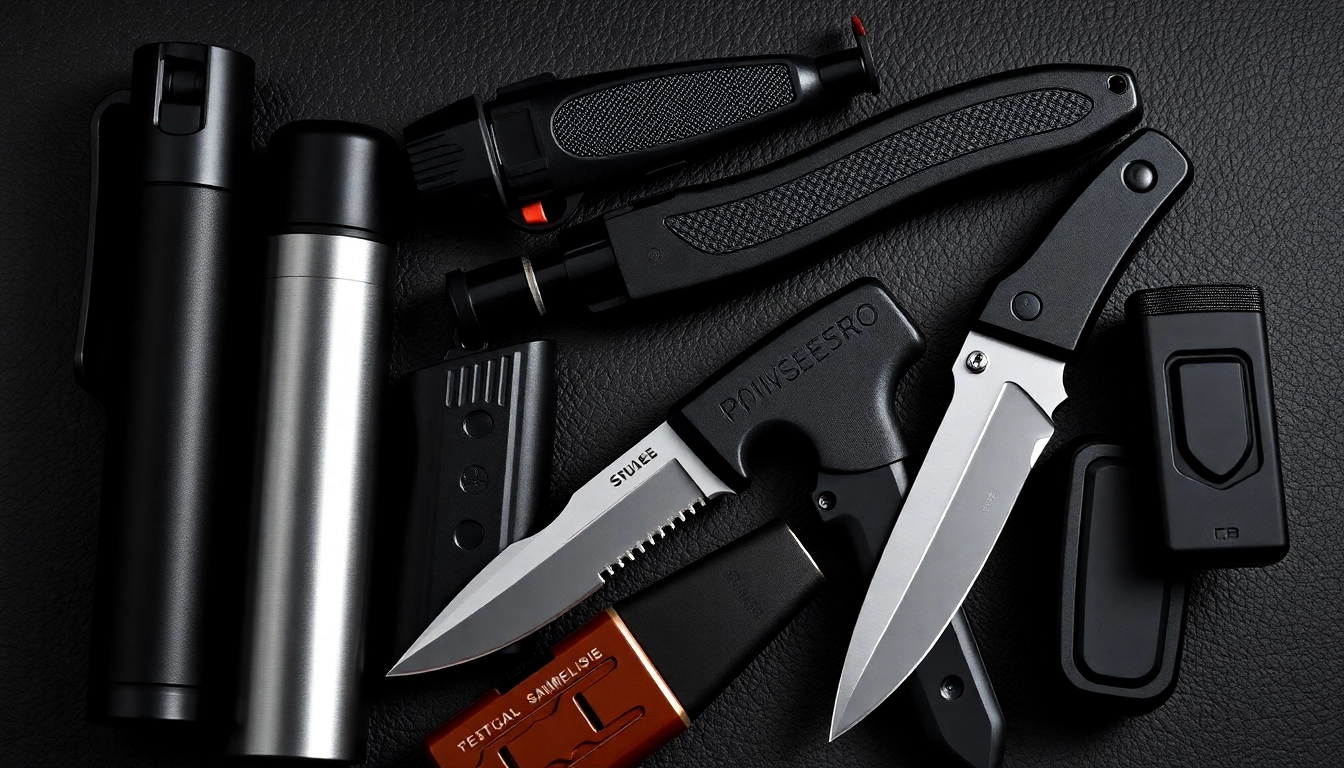Understanding Self-Defense Weapons: Types and Legal Considerations
In today’s increasingly unpredictable world, personal safety has become a paramount concern for many individuals. Whether commuting in busy urban environments or enjoying outdoor activities, having effective means of self-defense provides peace of mind and an essential layer of protection. The field of self-defense weapons encompasses a broad spectrum of tools—ranging from non-lethal devices designed to incapacitate an attacker temporarily, to lethal options intended for serious threats. Navigating this landscape requires a clear understanding of the various types of self-defense weapons, their legal status across different jurisdictions, and their appropriate application in real-world scenarios. To effectively safeguard yourself, it’s crucial not only to select the right self-defense tool but also to be informed about the legal regulations governing their use and possession.
Understanding Self-Defense Weapons: Types and Legal Considerations
Non-Lethal vs. Lethal Self-Defense Weapons
Self-defense weapons are broadly categorized into non-lethal and lethal options, each serving different purposes and matching different threat levels. Non-lethal weapons are designed to incapacitate an attacker temporarily without causing permanent injury or death. Examples include pepper spray, stun guns, personal alarms, and certain batons. These tools are favored for their effectiveness, ease of carry, and generally favorable legal status in many regions. They allow individuals to escape dangerous situations with minimized risk of legal repercussions or criminal charges.
On the other hand, lethal self-defense weapons include firearms, knives, and other tools capable of causing fatal injuries. These require a higher level of responsibility, legal compliance, and training due to their potential to end lives. While lethal weapons can be highly effective, their use is often heavily regulated and should only be considered when absolutely necessary for self-protection.
Understanding the distinction between these categories helps empower individuals to choose the right tool based on their comfort level, legal constraints, and specific security needs.
Legal Regulations in Different States and Countries
Legal considerations form a critical component of self-defense planning. Laws pertaining to self-defense weapons vary widely across states and countries. For instance, some regions prohibit the possession of certain knives or stun guns, while others impose strict licensing requirements on firearms. In the United States, the legality of items like pepper spray and stun guns is generally permissive, but restrictions may apply regarding spray size or device type—details that differ by state.
In California, for example, only certain types of pepper spray are legal, and stun guns may require registration or may be outright prohibited in specific areas. Conversely, the UK imposes strict limitations on lethal weapons and emphasizes personal alarms and legal self-defense sprays as safer alternatives. Always stay informed about local laws before acquiring or carrying any self-defense weapon. Non-compliance can lead to severe legal penalties, even if you intended to protect yourself.
Legal regulations are also subject to change, making it prudent to consult official sources or legal professionals regularly. Resources such as this legal guide in the UK provide valuable updates and clarification.
Furthermore, understanding the concept of ‘reasonable force’ and the circumstances under which self-defense is justified is vital. Use of excessive force can lead to criminal liability, regardless of the possession of a self-defense weapon.
Choosing the Right Self-Defense Weapon for Your Needs
Selecting an appropriate self-defense tool hinges upon multiple factors—personal comfort, legal regulations, physical ability, and the typical threat scenario. Here are some guiding principles:
- Assessment of threat environment: Urban settings may require different tools than rural areas or personal travels abroad.
- Ease of carry and concealment: Compact, lightweight options like personal alarms or keychain pepper sprays ensure discreet protection.
- Training and familiarity: Choose weapons you can operate confidently under stress. For example, some individuals prefer stun guns over firearms due to ease of use.
- Legal compliance: Verify regional restrictions before making a purchase.
- Long-term maintenance and reliability: Select durable, high-quality devices to ensure functionality when needed.
Balancing these factors helps ensure you are well-equipped to respond effectively to various threat levels while remaining within legal limits.
Top Self-Defense Weapons for Personal Security
Pepper Spray and Chemical Defenses
Pepper spray remains one of the most popular self-defense tools due to its proven effectiveness and ease of use. Derived from natural chili peppers, it causes intense irritation of the eyes, skin, and respiratory system, allowing for quick escape. Modern formulations are compact, often fit on keychains, and some include UV markers for attacker identification.
Choosing the right pepper spray involves considering distance—most effective within 6 to 10 feet—and legal restrictions. For example, some states limit spray size or require registration. When deploying pepper spray, aim at the attacker’s face for maximum effect, but always ensure safe handling to prevent self-injury.
Chemical defenses can also include mace or tear gas; however, pepper spray tends to be more user-friendly and less restricted in many jurisdictions.
Stun Guns, Tasers, and Electric Shock Devices
Stun guns and tasers deliver a high-voltage, low-current electric shock designed to temporarily disable an attacker. Their non-lethal nature makes them suitable for individuals seeking a balance between effectiveness and safety. These devices often feature quick activation mechanisms and some incorporate flashlights to improve aiming in low-light conditions.
Training in proper deployment is essential — misfiring or misusing can reduce effectiveness or cause accidental injury. Tasers are typically more effective at longer ranges but may be subject to stricter regulations depending on the jurisdiction. Devices like Byrna SD, which fire pepper-filled rounds using CO2, combine the electric shock concept with chemical deterrent, expanding versatility.
Knives, Batons, and Discreet Carry Options
Traditional self-defense tools such as folding knives and expandable batons offer immediate response capabilities. Folding knives are legally permissible in many areas and can serve both everyday and defensive purposes if carried responsibly. Batons provide a striking mechanism that can incapacitate an assailant with proper training.
Discreet carry options include canes with hidden compartments or everyday objects like umbrellas reinforced for self-defense. Such tools are especially popular among seniors or those needing a less intimidating method of protection. However, effective use demands proper training and familiarity with the tool to avoid escalation or legal issues.
How to Effectively Use Self-Defense Weapons
Training and Safety Precautions
Proficiency with your self-defense weapon significantly increases its effectiveness. Consider enrolling in self-defense classes or training workshops that focus on practical techniques and legal considerations. For example, pepper spray users should practice correct aiming and spray dispersal, while stun gun users must understand safe contact methods to avoid self-shock or injury to bystanders.
Always handle your tools with caution—store them securely but accessible. Regular drills help embed muscle memory, ensuring quick and confident deployment during emergencies. Remember, misuse or accidental discharge can have legal consequences, so adhere to safety guidelines strictly.
Situational Awareness and Prevention
The most effective defense is avoiding dangerous situations whenever possible. Maintain awareness of your surroundings, avoid isolated or poorly-lit areas, and trust your instincts. Tech tools like personal alarms can alert others or deter an attacker preemptively. Developing good habits reduces reliance on self-defense weapons and enhances overall safety.
In case defense is necessary, remain calm, assess the threat level, and choose the appropriate tool swiftly. Verbal de-escalation and escape routes should always be prioritized when possible.
Legal Self-Defense Tactics and Self-Protection Tips
Use your self-defense weapons only when justified and necessary. Knowing local laws about self-defense can prevent legal complications. Document incidents carefully, and seek legal counsel if involved in a confrontation. Practice ethical self-defense—avoid excessive force and always aim to protect yourself without escalating violence.
Effective self-protection combines physical tools with mental preparedness and awareness. Staying informed and practicing regularly enhances your ability to respond appropriately under stress.
Innovative and Hidden Self-Defense Tools
Disguised Weapons and Everyday Carry Items
The market offers a variety of disguised weapons designed for inconspicuous carry. Items such as keychain stun guns, lipstick pepper spray, or wallet-sized tasers blend seamlessly with everyday belongings, allowing discreet protection without raising suspicion. These innovations provide a strategic advantage—attackers are less likely to recognize their threat until it’s too late.
Other clever options include accessories like pens with built-in stun capabilities or Bluetooth-enabled alarms disguised as jewelry. Proper training on activation and usage remains essential to leverage these tools effectively.
Personal Alarms and Electronic Deterrents
Personal alarms emit loud, attention-grabbing sounds when activated, startling an attacker and alerting bystanders. Many models come with LED lights and are small enough to clip onto clothing or bags. Electronic deterrents also include GPS tracking devices or remote alert systems linked to authorities or trusted contacts, providing immediate assistance in emergencies.
These tools are particularly suitable for children, seniors, or individuals in high-risk environments due to their ease of use and non-violent nature.
Emerging Trends in Self-Defense Technology
The latest advancements focus on integration, connectivity, and smart technology. Wearable devices equipped with sensors can detect sudden falls or aggressive motions, automatically triggering alarms or notifying contacts. App-based systems allow users to activate self-defense features remotely or share their live location in real-time.
Miniaturization of stun devices, longer-range pepper sprays, and AI-powered situational analysis are shaping the future of self-defense technology, offering more effective and user-friendly options.
Maintaining and Selecting Self-Defense Weapons for Longevity and Effectiveness
Proper Care and Storage
To ensure your self-defense tools remain functional when needed, regular maintenance is essential. Keep electronic devices charged and store them in accessible places, away from extreme temperatures or humidity. Powdered sprays should be stored upright and protected from accidental discharge, while metal tools like batons require periodic inspection for wear or damage.
Adopt a routine of checking and cleaning, replacing expired items, and updating training to maintain readiness.
Updating Your Self-Defense Arsenal
As technology evolves and legal landscapes shift, it makes sense to periodically review and upgrade your self-defense arsenal. Consider new innovations, additional training, or supplementary tools to adapt to changing threats. Participating in workshops or consulting security experts can guide you toward the most effective and compliant options.
Keep abreast of legal changes and market developments to avoid possessing outdated or restricted items, ensuring your safety measures remain legal and effective.
Legal and Ethical Responsibility
Possessing a self-defense weapon carries responsibility. Always use your tools ethically, respecting the rights of others and adhering to the law. Use force proportional to the threat; excessive response can lead to criminal charges. Be aware of the consequences of misusing or mishandling weapons, and seek ongoing education about self-defense laws.
Educating yourself on proper usage and defending your right to safety within the confines of legality exemplifies ethical responsibility as a responsible citizen.









